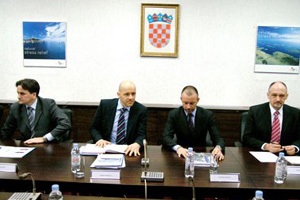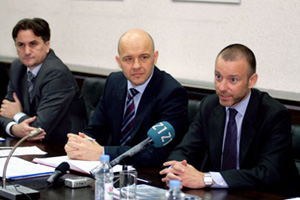- Published: 18.03.2010.
Airports have to adapt to the low-cost model
 Time of the crisis should be used for the preparation of new projects, and therefore the Government will decide by the end of the year on the direction of the development of seven airports that are mainly owned by the State, and also will be considered the possibility of entry of the private capital into the Project, said Drazen Breglec, the State Secretary for the Transport at today's press conference.
Time of the crisis should be used for the preparation of new projects, and therefore the Government will decide by the end of the year on the direction of the development of seven airports that are mainly owned by the State, and also will be considered the possibility of entry of the private capital into the Project, said Drazen Breglec, the State Secretary for the Transport at today's press conference.
The conference was held after the meeting with Olivier Jankovec, Director General of the Association of the European Airports (ACI Europe), who participated in Dubrovnik at a two-day conference on the European small and medium-sized airports named "Airports as an engines of the economic recovery".
Although the presented data about the decline of the air traffic in the last year (about 9% fewer passengers, and cargo transport by 5.5% lower), Breglec said that there are predictions by which to air traffic in the Europe to double by the year 2030, and therefore, Croatia needs to prepare a significant investments in the airports infrastructural development.
Aviation industry sufferred the largest crisis last year, and the European airports lost about 100 million passengers, and were faced with the difficult access to the bank's financing funds, and were faced with cutting costs at the expense of the investments, said Jankovec noting that recovery starts, but only for those airports that have contracts with the low cost air carriers.
Jankovec welcomed the announcement of a new management system in the Croatian airports, as well as the efforts of the Croatian Government in  the approximation of the Croatian legislation with the EU in the field of an air traffic, and Jankovec stressed out that the Croatian market has great potential, especially in the tourism.
the approximation of the Croatian legislation with the EU in the field of an air traffic, and Jankovec stressed out that the Croatian market has great potential, especially in the tourism.
However, Jankovec said that the Croatian and European airports need to adjust their business conditions due to the conditions of the low-cost airline companies, which are becoming dominant, and that L.C. companies will realize until the end of the year 2013 about 50% of the total traffic at the European airports. But at the same time, Jnakovec believes that the airports should provide traditional services for the 'classic' air carriers.
Zagreb airport director Tonci Peovic, who is also vice of the SMAG's (Association of the Small and Medium-sized Airports up to 5 million passengers, which operates within the ACI Europe), believes that the Croatian airports will achieve the growth in this year, and manage to maintain the international status due to the entrance in the EU.
Peovic said that the Zagreb airport lower prices for the low-cost carriers in this year, and six of them received more than nine flights to the European destinations. At the same time, the Zagreb airport is continuing with the investments in the existing passenger terminal, as well as the activities that are initiated to build a new terminal, and also the restructuring of the company is in the progress.
The biggest problem in the realisation of the new terminal is the decision to change the existing location to another location wich is partly in private posession, 100 meters in  lenght to the east, and that option raises the price of the construction in total of an additional 50 million EUR. Additional problem, as he says, is the high construction costs of the estimate value of 360 million EUR. In his opinion, the new terminal should not be more expensive than 180 million EUR, and should be built in phases, and at a different location.
lenght to the east, and that option raises the price of the construction in total of an additional 50 million EUR. Additional problem, as he says, is the high construction costs of the estimate value of 360 million EUR. In his opinion, the new terminal should not be more expensive than 180 million EUR, and should be built in phases, and at a different location.
It is expected that the Government will soon make choise between the two models of the funding. The first possibility eventualy would include the entry of a strategic partner by the BOT model, and the second possibility is the ability to withdraw up to 75% of a necessary funds from the EU Cohesion Funds, which are intended to the infrastructure projects, when Croatia joins the Union.


